India is a land of festivals that vary from region to region. The biggest festival in Kolkata is Durga Puja. Another festival, Saraswati Puja in Kolkata is celebrated with fervour and gaiety on Vasant Panchami, the first day of spring. Saraswati is the goddess of knowledge and art. A visit to Kolkata at this time is a cultural trip into the festivals of India.
“Jaya Jaya Devi, Charachara Sharey, Kuchayuga Shobhita, Mukta Haarey
Vina Ranjita, Pustaka Hastey, Bhagavati Bharati Devi Namohastutey”
– Saraswati Mantra
Contents
Saraswati Puja in Kolkata
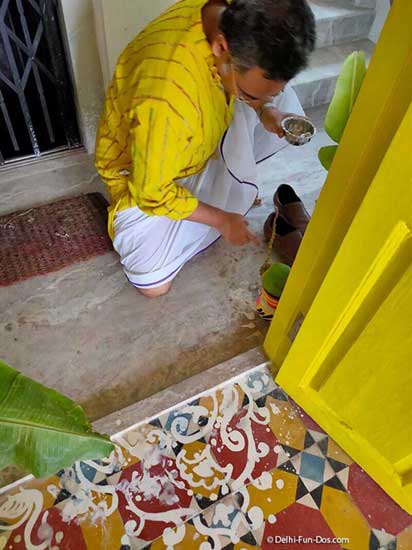
When you talk about festivals of Kolkata, more often than not, you have Durga Puja in mind. But Kolkata, the Cultural Capital of India, has been a melting pot. Kolkata, or the erstwhile Calcutta, was the administrative capital of British India till the year 1911. It was the hub of activities and a host of cultural as well as religious festivals kept the social calendar busy. Some of these festivals are now obsolete. But some have stood the test of time and are still celebrated with fervour, albeit with some changes. Saraswati Puja is one such festival that still evokes a lot of excitement among young and old in the city.
What is Saraswati Puja?

Hinduism, the oldest religion in the world, manifests in a host of divine qualities. For instance, Goddess Durga is the slayer of evil and protector of good. Similarly, Saraswati is the presiding deity for art and knowledge. Hindu worship is called Puja. A surprising aspect of Hindu festivals is that the same deity is worshipped differently in different parts of India. By way of explanation, as we have observed, Hinduism is not a codified religion and has changed from, one region to another in the country. Therefore the diversity of food, language, art, and culture and also weather and topography has led to different styles of worship of the same deity different times of the year.
Saraswati Puja in southern parts of India is celebrated annually in autumn. But Saraswati Puja, in Kolkata and other places in Eastern India, is celebrated in spring, on the auspicious day of Vasant Panchami.
Indian deities are often given symbolic forms by way of statues or pictures. Saraswati is the embodiment of simplicity and devotion, qualities needed for pursuing any form of knowledge. Saraswati is therefore represented as a lady playing the Indian string instrument Veena. She is clad in a white or light yellow sari and is accompanied by her vehicle, the swan.
Saraswati Puja in Kolkata is celebrated with enthusiasm and gaiety at homes, in schools or educational institutions or as a community festival in neighbourhoods.
Why do we observe Saraswati Puja during Vasant Panchmi?
Saraswati Puja in Eastern India takes place at the cusp of winter and spring. The morning breeze is still nippy but spring is in the air. India is a majorly agrarian economy and this time of the year is slow in terms of agriculture in Eastern India. People, therefore, have more time to celebrate. The day of Vasant Panchami (Vasant means “spring”) marks the onset of spring and Saraswati Puja is celebrated to start the season with divine blessings. Hence, we observe Saraswati Puja on Vasant Panchami.
What do you do on Saraswati Puja?
Durga Puja indeed features among the most popular Indian festivals. While there is a lot of tourist influx in Kolkata in that season, Saraswati Puja is a great time too. This festival is held in the last week of January or the first week of February every year. It is early spring and the weather is very pleasant for travelling to Kolkata. If you wish to experience a popular Bengali festival and delve into the rich culture, you can plan your Kolkata trip around Saraswati Puja.
On the occasion of Saraswati Puja, a host of colourful pandals or marquees are erected across the city. Some are simple cloth-bamboo combination while some of them are artistically designed with offbeat material such as jute, cane strips, rattan. Creativity can run wild here and we recall seeing pandals made with sugar cane fibre, tin strips, dokra craft and so on. The city turns into an art gallery on the occasion.
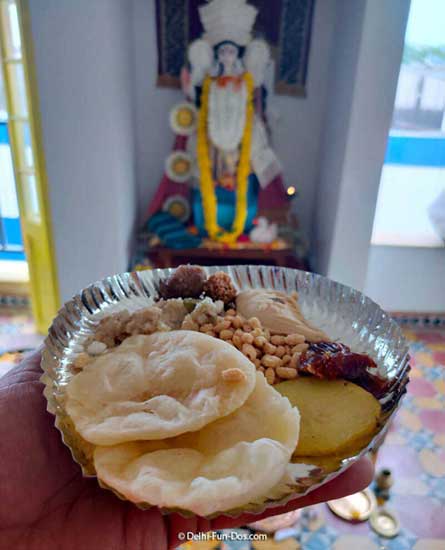
You can potter from one marquee to another viewing the art and installations. Visitors are wholeheartedly welcomed at the worship sites. This could be a shutterbug’s delight. People are dressed in their festive best and spirits are high. Music played on sound systems wafts in the air. Food offerings or Prasad is shared with a visitor. While Saraswati Puja is a Hindu festival, anyone notwithstanding caste, creed, or religion may participate. If you wish to partake in the worship process, we suggest you go to the nearest temple. More often than not, Saraswati Puja is organized in neighbourhood temples as well and you can participate in Anjali – flower offerings to the deity amid chanting of mantras. This is the most satisfying feeling.
Cultural programs are common in the evenings. School students or residents of a neighbourhood would assemble and impromptu programs such as songs, dances, and recitations, would be performed by children as well as adults. Sometimes, rehearsed skits and plays would be performed. These events are often held on an open stage. Traditionally, classical items would be performed. Over time, many contemporary pieces are also presented. You can spend the evening listening to Rabindra Sangeet watching an Odissi performance or swaying to a popular Hindi cinema number.
For a more immersive experience, approach your host or any friend in the city and visit their home during Saraswati Puja. You would need to have at least 2 to 3 hours to spare since Indian festivals are not very punctual. But what you would gain is a lot of insight into the Indian culture.
How to do Saraswati Puja at home
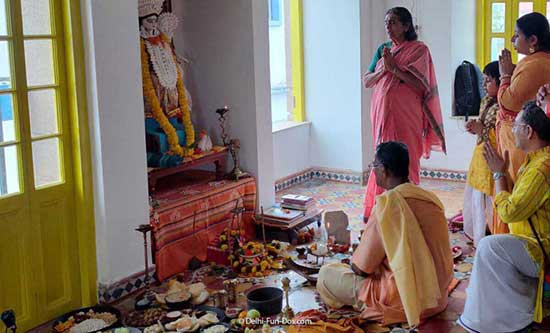
The festival takes us back to childhood when we would wait impatiently throughout the year for this day. Students are not supposed to touch a book or pen on the day of Saraswati Puja. So, as a child, it was one super rare day in the year when, on the divine commandment, we were allowed to skip homework.

Preparation for the festival started at least a week before. We would accompany our parents to the nearest Kumortuli or the closest market at Gariahat to buy the clay idol that would be worshipped. That itself was a task. For once, we would be given the responsibility of selection. The right to choose was a rarity those days and we would be very fussy. We would pull the parent, from one shop to other, inspecting hundreds of options available in all possible sizes. If we liked something, the parent would not approve since it was larger than what would fit the altar or more expensive than the budget. So it would be hunt time all over again. Finally, we would select another idol and by this time the tired parent would have lost all interest or zeal and would agree, pay, and be done with it. It would be our triumph. During the course of the week, parents would visit the market multiple times to buy fruits, vegetables, other groceries, and ritualistic ingredients needed for the Puja.
The evening before the Puja would be most exciting. We were allowed to be up throughout the night cleaning and decorating the makeshift altar with colourful fabrics, designs cut out from paper, shola-pith paisleys, and draw ornate floor paintings or Alpona. Our books and pens would also be placed on the altar for blessings. It would be dawn when we were satisfied with what was our first effort at installation art. The idol would be placed on the altar and decorated with fresh marigolds or tuberose garlands.
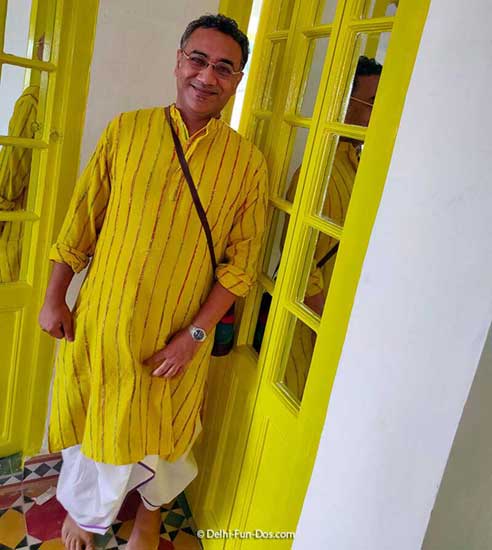
We would then shower, wear Indian clothes like Panjabi-Pajama (Kurta Pajama) or tie a dhoti and look all dressed up. Girls would wear yellow shade saris and kid-size saris would be available in the market this season. After freshening up, we would be allowed to help our mother who would be busy in the kitchen cooking the offering or Bhog. The all-vegetarian offering would comprise Payesh (rice pudding), Khichuri (rice and lentil dish), vegetable fritters, and Luchi (inflated fried bread). Fruits, sweets, and Mishti Doi or yogurt would be served on the side.
At last, lamps or diyas would be filled with oil; a hand-rolled wick would be placed and then lit. The effect would be dramatic, festive, and special.
After that was an endless wait for the priest who would visit various households and perform the ceremonies. He would obviously be delayed and we devotees, fasting till the ceremonies were over, would be very impatient. Finally, there would be a buzz and the priest in his simple dhoti and shirt would arrive and perform the ceremonies. We, the devotees would make flower offerings while repeating the mantras that the priest chanted. That was the last stage of rituals and we would wait for the consecrated food, or Prasad, to be served. It was feasting and fun after that. We would visit neighbours and check out the community Saraswati Puja and have Prasad wherever we got an opportunity.
Interestingly, parental discipline would be somewhat relaxed on Saraswati Puja allowing youngsters to interact freely just this one day. Many teenage love stories would blossom this day. Saraswati Puja is the de facto Valentine’s Day of Kolkata.
As the day would come to an end, we would be filled with sadness. The wait for another year seemed long. But such was life and we would be back in our schools one day after that.
Hate Khori ceremony

Hate Khori ceremony is a ritual where children in the age group of 3 to 5 years ritualistically start their student life. During Saraswati Puja, the children performing Haate Khori begin their academics by writing the first letter of Bengali alphabet on a slate with a piece of chalk. The priest invokes Goddess Saraswati’s blessings on the first writing and the new student so that they can excel in the pursuit of knowledge throughout their lives.
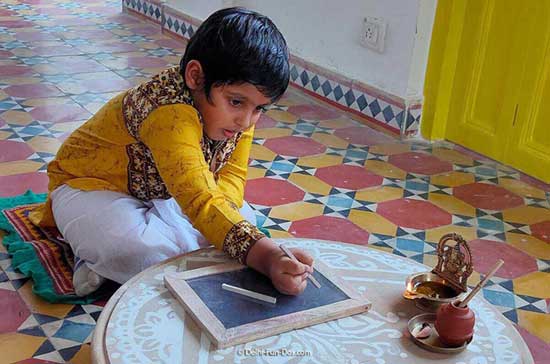
In real terms, this festival is a most amusing sight. The Hate Khori candidates are showered in the morning after applying the auspicious Haldi or turmeric. They wear new clothes – boys are clad in baby dhotis and little girls wear small saris or a ghagra skirt. In sync with the festival, the clothing is in shades of yellow. Each child looks like a sparkling new coin freshly out of the mint. But the little ones do not have a care in the world. They are busy running around behind each other, oftentimes tumbling down because of the unfamiliar clothing. At the ordained moment, the parents go running after them and they are fetched near the altar. Some of the proteges find the proceedings unusual and entertaining while some are impatient and attempt to scoot. And then the exhausted parents catch them and bring them back again to complete the ritual.
Pro-tip: Saraswati Puja books
Saraswati Puja is like worshipping the pursuit of knowledge and can be performed by anyone. The legendary shehnai maestro Ustad Bismillah Khan, a practising Muslim, would celebrate Saraswati Puja at his home in Banaras. If you wish to perform Saraswati Puja at home but do not have access to a priest, not to worry. There are books galore in Bengali, English and other languages that explain the process of worship in lucid language. They also list the necessary ingredients, the mantras with meanings and the sequence of events during the ritual. You can procure a physical copy of the book or simply download an online version. You are then all set to experience your own Saraswati Puja.
PIN IT FOR LATER READ


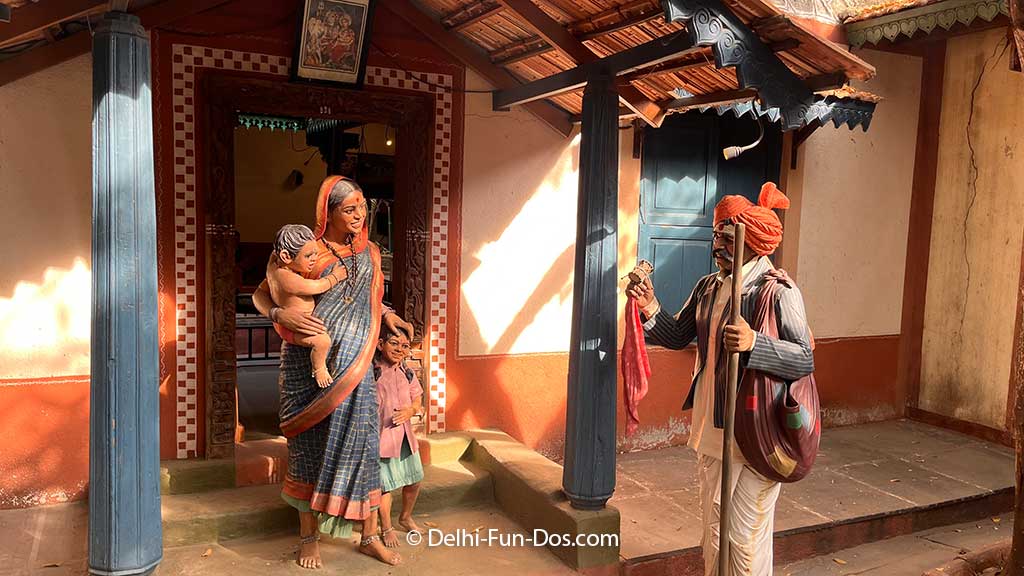

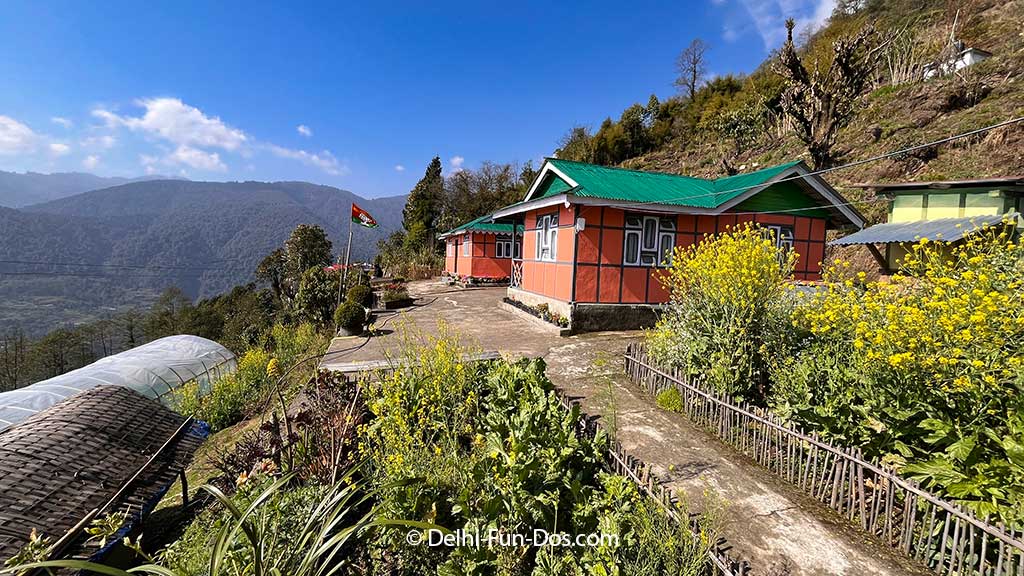
This is one of my most favorite pujas. we do it every year in my home. Its so much fun.